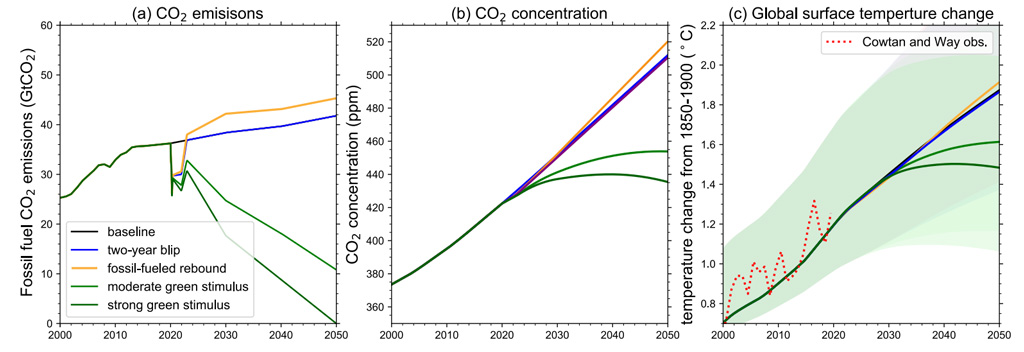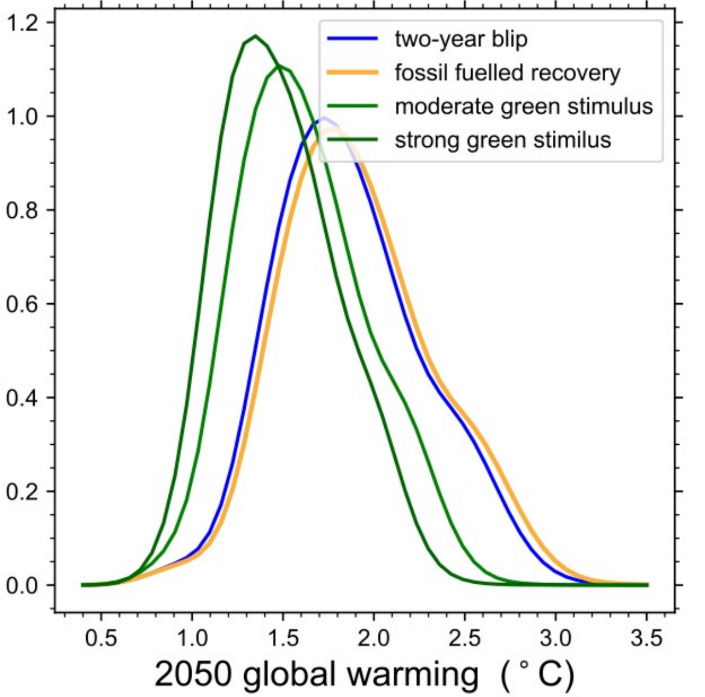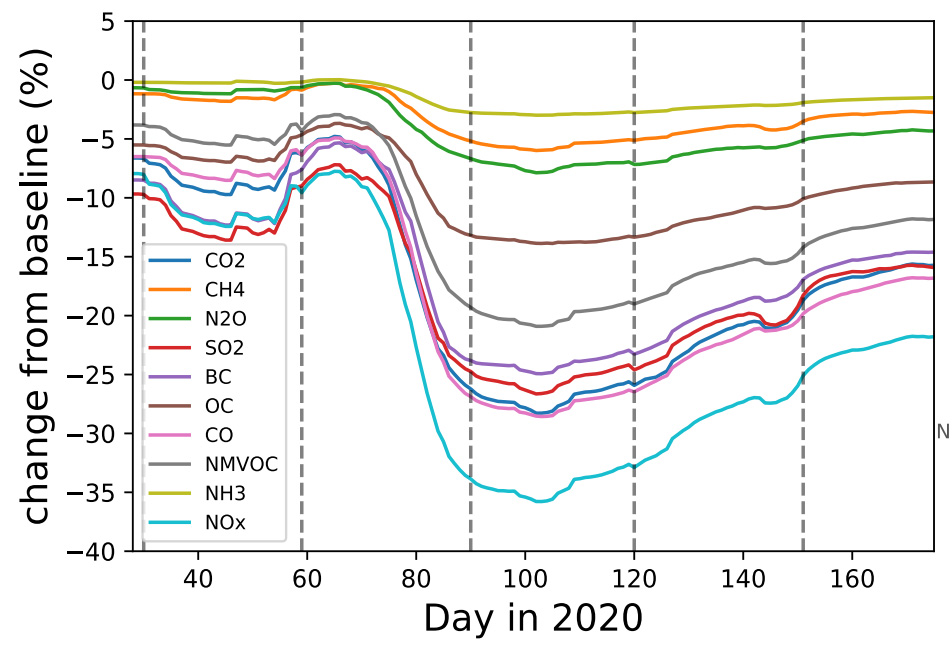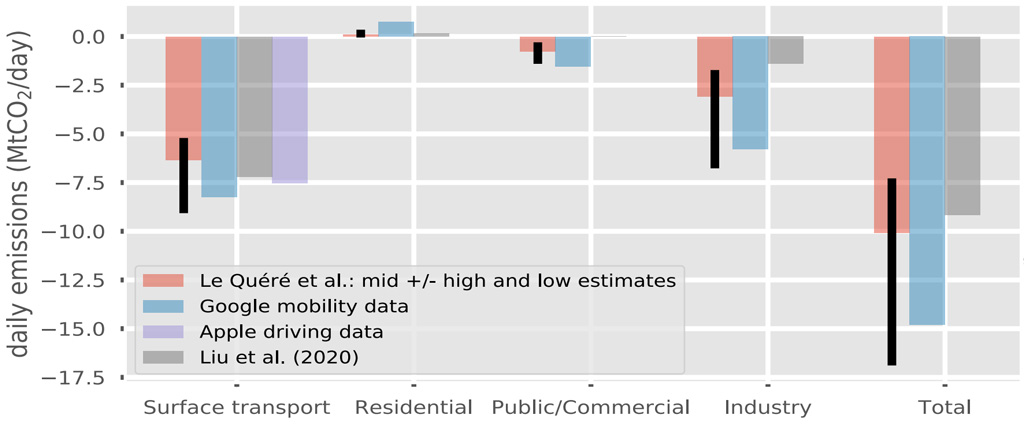
Coronavirus: Green recovery ‘could prevent 0.3C’ of warming by 2050
Josh Gabbatiss
08.07.20Josh Gabbatiss
07.08.2020 | 10:00amThe world could avoid 0.3C of global warming by the middle of the century if governments invest in a strong “green recovery” from coronavirus, according to a new study.
With existing policies likely to push the temperature rise beyond 1.5C by 2050, the lead author tells Carbon Brief the pandemic provides a “make or break” opportunity to change course and meet the highest ambition of the Paris Agreement.
Global emissions have seen a significant, but temporary drop as lockdowns confined people to their homes and travel came to a standstill. But this temporary dip will only prevent around 0.01C of warming, says the new study in Nature Climate Change.
It models different ways that the world could recover from the Covid-19 crisis, finding lasting climate benefits would only come about with a significant push for low-carbon investment at the expense of fossil fuels. Another researcher tells Carbon Brief such proposals still largely remain to be seen.
Green stimulus
Having first analysed the short-term emissions changes resulting from global lockdowns (see below for details of their methods), the authors use future scenarios to test the impact of different pandemic responses, compared to a hypothetical baseline without coronavirus.
In the baseline, countries meet their Nationally Determined Contributions (NDCs) to the Paris Agreement, but do not strengthen their ambition over time. As a result, global temperatures are likely to rise by nearly 2C above pre-industrial levels by 2050.
The paper then looks at four responses to the coronavirus crisis that either help or hinder efforts to limit warming. The projected impact of each of these scenarios on CO2 levels and future temperatures can be seen in the charts below.

Each scenario begins with a “two-year blip” in emissions resulting from lockdowns and then proceeds with different levels of support for “green” stimulus or fossil fuels.
- IEA: ‘Green’ coronavirus recovery would keep global emissions below 2019 peak
- Coronavirus: Tracking how the world’s ‘green recovery’ plans aim to cut emissions
- Webinar: What impact is Covid-19 having on global CO2 emissions?
- Q&A: Could climate change and biodiversity loss raise the risk of pandemics?
- Analysis: Coronavirus set to cause largest ever annual fall in CO2 emissions
- Coronavirus: What could lifestyle changes mean for tackling climate change?
- Analysis: Coronavirus temporarily reduced China’s CO2 emissions by a quarter
The first pathway assumes that by the end of 2022, emissions return to baseline levels expected if countries meet their NDCs up to 2030, but do not increase climate action.
The paper then looks at a scenario in which countries turn to investments in coal, oil and gas as they attempt to promote a recovery from the pandemic.
World governments make investments equivalent to an extra 1% of global GDP in fossil fuels, resulting in emissions being 10% higher than the baseline by 2030.
In these three scenarios, the results show warming (since the pre-industrial era) increasing from around 1.2C today to roughly 1.8C in 2050, but with a roughly 40% chance of exceeding 2C. (While a figure of 1.1C warming so far is often reported, study leader Prof Piers Forster from the University of Leeds’ Priestley International Centre for Climate says that there is variation in estimates.)
The figure below gives a sense of how likely these pathways are to exceed the two Paris Agreement temperature goals. Around 80% of the model runs for these scenarios resulted in warming of more than 1.5C and 40% led to warming of more than 2C, corresponding to the area under the curves beyond those temperatures. (The original paper contained a typographical error indicating an 80% chance of exceeding 2C.)

Two scenarios for a green recovery are outlined. “Moderate” green spending sees an additional 0.8% of GDP going to low-carbon energy and efficiency measures and 0.3% less going to fossil fuels, compared to current policies, while “strong” green stimulus results in 1.2% more and 0.4% less, respectively.
These pathways result in 35% and 52% decreases in greenhouse gas emissions by 2030.
Study co-author Dr Matthew Gidden of Climate Analytics says the different investment options are based on scenarios laid out in a 2018 Nature Energy paper, examining necessary conditions to meet the Paris Agreement targets and the Sustainable Development Goals (SDGs).
Under the moderate green stimulus scenario, 0.2C of temperature rise is avoided and warming reaches around 1.6C, keeping it below the 2C target set by the Paris Agreement.
The strong green stimulus scenario avoids 0.3C of temperature rise, limiting warming to roughly 1.5C. The team says there is a “good chance” – around 55% – of staying within this limit, therefore, meeting the higher ambition of the Paris Agreement.
‘Undetectable’ impact
Green stimulus is important because, according to the team’s calculations, the direct impact of the pandemic response on climate change will be “negligible”.
Despite estimating significant declines in global emissions this year, the authors conclude that, even if some lockdown measures remain until the end of 2021, temperatures will only be around 0.01C lower than expected by 2030.
Dr Glen Peters of Norwegian climate institute Cicero, who was not involved in the new study, tells Carbon Brief this “undetectable” impact on temperature rise is similar to a “back of envelope” result he arrived at in May.
This is also supported by recent Carbon Brief analysis of atmospheric CO2 from Prof Richard Betts of the Met Office, which concluded that while CO2 build-up will be slower than expected this year, “it will not be enough to substantially slow global warming”.
In the new paper, the researchers accounted for declines in other pollutants which can impact cooling and warming, namely NO2 and SO2. Ultimately, however, Peters says the effect is still small:
“Whatever changes in temperature, they will be well within natural variability.”
‘Make or break’
In order to derive any long-term benefit from the current situation, the study authors emphasise the need for governments to invest in low-carbon energy and energy efficiency, and to avoid bailouts for fossil-fuel companies.
Equating to $1.7tn, the 1.2% GDP figure used in the strong green stimulus pathway would mean a significant increase from current levels of green spending, according to Brian O’Callaghan, a PhD candidate at Oxford University’s Smith School of Enterprise and the Environment who was not involved in the study.
O’Callaghan, who recently co-authored a paper on the need for green stimulus, tells Carbon Brief that even relatively “ambitious” packages put forward by the Germany and the EU are yet to pass this “strong green stimulus” threshold:
“A 1.2% GDP target would require new and ambitious green spending commitments from most nations, and in particular from large emitters like the US, China and India.”
Carbon Brief has been tracking the green commitments in governments’ post-coronavirus recovery plans, but many of the world’s highest emitting nations have yet to release significant packages. As O’Callaghan explains:
“At this stage all global scenarios remain on the table – the future of our planet could quite literally be decided by the spending actions of governments over the coming months.”
Forster agrees this is a “make or break” moment for global climate targets. “Before we had coronavirus we weren’t on track, we absolutely weren’t,” he tells Carbon Brief. But he says that the crisis presents an opportunity to change course: “If we don’t do it today I think we won’t ever be able to, unfortunately.”
Mobility data
Since the onset of the pandemic there have been numerous estimates, including a few by Carbon Brief, assessing the impact of international lockdown measures on emissions.
Before modelling future scenarios, the new paper examined trends for 10 greenhouse gases and air pollutants in 2020 so far, shown in the chart below, using mobility data collected by Google and Apple.

The authors used this information to estimate emissions not only from transport, but also other sectors, such as industry and homes, based on people’s movements.
Forster says he saw an “exciting opportunity” to access “almost every single country” with this data. “There are people with these telephones everywhere,” he tells Carbon Brief.
Despite this, there were gaps from countries where Google data is not available, notably for China, Russia and Iran, as well as for aviation and shipping.
The team plugged these gaps using methods developed for another recent paper led by Prof Corinne Le Quéré of the University of East Anglia’s Tyndall Centre, who is also a co-author of the new study.
The combined datasets expanded the analysis of CO2 emissions from the 69 nations covered in Le Quéré’s paper to 123, accounting for more than 99% of global emissions.
The authors concluded that the decline peaked in mid-April when global CO2 emissions fell by around 30%, largely driven by the drop in road, rail and sea travel.
The new estimates are high compared to the recent study by Le Quéré and unpublished results by a team led by Prof Zhu Liu of Tsingshua University, as the figure below shows.

The researchers say they are confident the mobility data provides accurate values for surface transport, and this lines up well with previous studies, but using such data for other sectors is “likely to overestimate” emissions changes.
Liu, who was not involved in the new study, tells Carbon Brief there are big uncertainties in the estimates of global daily emissions using personal mobility data, notably for industry because “most factories could still operate”, even with a much-reduced workforce.
However, Forster says he was reassured that their results matched up well with real-world measurements of NO2, another pollutant included in their study, which the paper says can provide a “useful bellwether” to test whether its wider estimates are accurate.
Moreover, he says these uncertainties have relatively little impact on the 0.01C figure for direct change in warming, which the team calculated would result from the pandemic:
“Perhaps that is too big, but it still isn’t that big at all, so I think we were quite comfortable with that being a high-end estimate.”
Forster, P. et al. (2020) Current and future global climate impacts resulting from COVID-19, Nature Climate Change, https://www.nature.com/articles/s41558-020-0883-0
-
Coronavirus: Green recovery ‘could prevent 0.3C’ of warming by 2050
-
Coronavirus: Green recovery provides a ‘good chance’ of hitting Paris climate target

